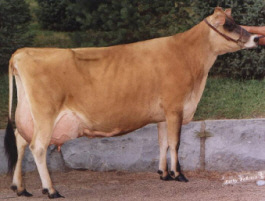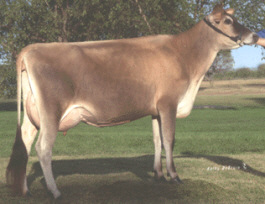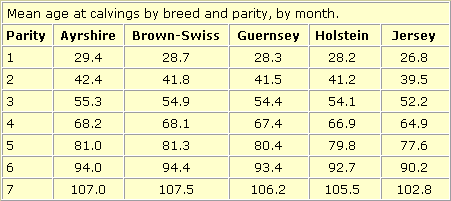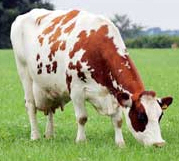



Jersey
History
Despite considerable research, nothing definite is known as to the actual origin of the cattle first brought to Jersey Island. Most research agrees, that the Jersey probably originated from the adjacent coast of France, where in Normandy and Brittany cattle resembling Jerseys are found.Whatever the correct phylogenetic form of the Jersey might be, it would appear, when analysing the available data, that the domesticated fore-father of the Jersey came from Asia, belonged in all probability to Bos brachyceros, was probably tamed during the Stone Age, some 10 000 years ago or more and migrated to Europe through Central and Southern Europe and North Africa to Switzerland and France. In Northern France some cross-breeding undoubtedly took place between the pure Bos brachyceros and Bos primigenius herds (which mostly came down the North Coast of Europe to as far down as Northern France).
 Photo courtesy of Covington Jerseys, www.covingtonjerseys.com |
Jerseys are known to exist in the UK mainland since 1741 and probably well before. At that time they were known as Alderneys.
The flourishing times for the breed was the period from the 1860s to the First World War when the Jersey cow enjoyed the greatest period of development for the breed worldwide. For many years, thousands of animals were shipped to the USA annually, but records show that early settlers took Jerseys there in 1657. Canada imported her first Jerseys in 1868. Jerseys first went to South Africa in 1880, and in 1862 New Zealand imported her first cattle.
Although records of earlier importations into Australia are not available, it is believed that the first Jerseys arrived as "ship cows." The first reference of a Jersey dates back to 1829 when Mr. J. T. Palmer of Sydney advertised the sale of 200 pure bred Jerseys.
Latin America imported its first Jerseys before the turn of the century. Records show that around 1892, the first cattle went to Guatemala. Brazil had its first Jerseys four years later. But it was probably Costa Rica that first imported the breed to Central and South America in 1873.
Today, the Jersey breed is the second largest breed of dairy cattle in the world. On Jersey itself there are fewer than 6000 Jerseys in total with nearly 4000 of these being adult milking cows. The purity of the breed on the island is maintained by a strict ban on imports. This ban has been in place for some 150 years. There are no other breeds of the cattle on the island.
Jerseys are well known for their milk which is noted for its high quality - it is particularly rich in protein, minerals and trace elements. It is also rich in colour which is naturally produced from carotene, an extract from grasses. The Jerseys has an ability to adapt to many kinds of climates, environments and management practices.
Characteristics
It is typically light brown in colour, though this can range from being almost grey to dull black, which is known as Mulberry. They can also have white patches which may cover much of the animal. A true Jersey will however always have a black nose bordered by an almost white muzzle.The Jersey hard black feet are much less prone to lameness.
The Jersey is relatively small in size - about 400 to 450kgs in weight and have a fine but strong frame.
Statistics
- Jerseys produces a pound of milk components at a lower cost compared to the other major breeds.
- She has little or no calving problems, greater fertility, a shorter calving interval, and earlier maturity.
- Jerseys stay in the herd longer than any other dairy breed.
- Jersey milk has greater nutritional value, plus the highest yield and greater efficiency when processed into cheese and other value-added products.

Photo courtesy of Covington Jerseys, www.covingtonjerseys.com - Jersey milk commands a premium price in many markets.
- Jerseys perform well under a wide range of systems and are well-known for their high feed conversion efficiency
- Jersey milk is in many ways unique. As a product it contains:- 18% more protein, 20% more calcium, 25% more butterfat than "average" milk.
- Jerseys are well-known to be less susceptible to lameness because of their black hoof colour which makes their hooves very hard. Because Jerseys are a lighter breed this may also give them less problems with lameness.
- Good Temperament is important in a dairy cow. In today's modern parlours rapid throughput is of top priority. An animal misbehaving by continually kicking, off the units will cause unwanted delays and even damage to the expensive equipment. Jerseys are thought to have the one of the best temperaments among, the dairy breeds, although a lot of this depends on the handling the animals receive.
Comparative
MilkScientific studies also show the Jersey cow produces milk more efficiently than other breeds. This can be especially important in countries where feed may be restricted. As well as making the Jersey a profitable option in agriculturally developed countries.
Calving

A study from USDA in 2005 showed Jerseys in the United States to show almost a 20% superiority in the number of easy calvings (with very low incidence of very difficult calvings) than other, larger dairy breeds evaluated in the same study, regardless of lactation.
Likewise, figures from the Canadian Dairy Network in 2005 show first lactation Canadian Jerseys to have 96% unassisted or easy pull calvings, while cows in subsequent lactations have 99% unassisted or easy pull calvings.
Health
Results from several investigations lead to the conclusion that Jerseys are less susceptible to mastitis, e.g., in dairy herds of Florida, mastitis and udder disorders were more frequent among Holsteins (51% of cows treated) vs. 22% for Jerseys.
Distribution
The Jersey can now be found across the world with some of the largest populations in countries such as Australia, Canada, Denmark, New Zealand, South Africa, USA, and Zimbabwe, and in the UK.References (the above information was cited from the following sites)
www.jerseycattle.org
www.whyjerseys.com
www.jerseycanada.com
http://studbook.co.za
www.covingtonjerseys.com


